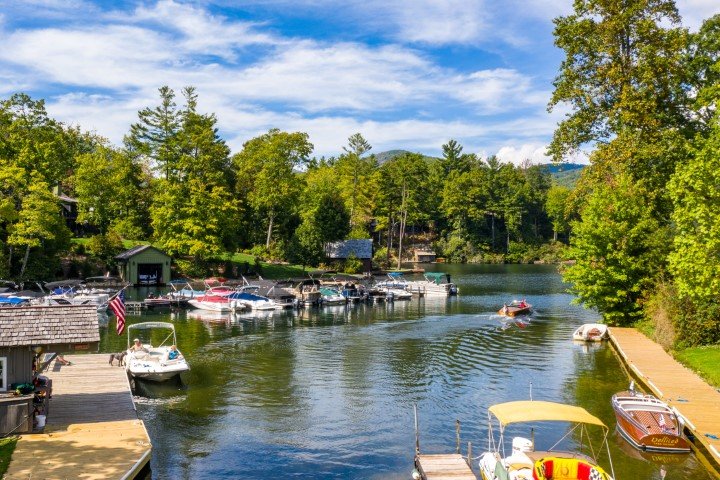Table of Contents
ToggleNorth Carolina is a state rich in natural beauty, from the towering peaks of the Blue Ridge Mountains to the sandy shores of the Outer Banks. But one of its most captivating and often overlooked features is its abundance of lakes. If you’ve ever wondered how many lakes in North Carolina, you’re not alone. With their stunning landscapes, recreational opportunities, and ecological importance, lakes are vital to the state’s identity.
In this article, we’ll explore how many lakes North Carolina has, what types of lakes exist in the state, which are the largest and most visited, and why they matter—environmentally, economically, and recreationally.
Understanding North Carolina’s Lake System
Natural vs. Man-Made Lakes
The lakes in North Carolina can be broadly categorized into two types: natural lakes and man-made reservoirs. Despite its varied topography, North Carolina has relatively few natural lakes. Most of the lakes that residents and tourists enjoy today were created by damming rivers and streams.
- Natural lakes: These include features like Lake Waccamaw, one of the few natural freshwater lakes in the southeastern U.S., believed to have formed from a meteor impact or geological subsidence.
- Man-made lakes: The vast majority of lakes in the state fall into this category. These were created for hydroelectric power, flood control, irrigation, and recreation.
So, How Many Lakes Are There?
According to the North Carolina Department of Environmental Quality (NCDEQ), the state is home to over 5,700 named and unnamed lakes and reservoirs that are at least 10 acres in size. However, when you include small ponds and man-made impoundments, the number easily exceeds 50,000.
While the precise number varies depending on definitions and classifications, there are approximately 50 major lakes that are commonly recognized for recreational use and state-level water management.
The Most Popular Lakes in North Carolina
North Carolina’s lakes are scattered throughout the state, from the mountain regions to the coastal plains. Let’s explore a few notable ones.
Lake Norman – The Largest
- Size: 32,500 acres
- Location: Near Charlotte
- Created by: Duke Energy (1963)
- Purpose: Hydroelectric power and recreation
Lake Norman is the largest man-made lake in North Carolina. It offers a vast area for boating, fishing, swimming, and lakeside living. The lake has become a popular destination for retirees and second-home buyers.
High Rock Lake – A Fisherman’s Paradise
- Size: 15,180 acres
- Location: Davidson and Rowan Counties
- Known for: Bass fishing tournaments
High Rock Lake is beloved among anglers and often hosts national fishing events. It also supports residential communities along its shorelines.
Lake Waccamaw – A Rare Natural Wonder
- Size: 8,936 acres
- Location: Columbus County
- Type: Natural lake
This is one of the few natural lakes in the southeastern U.S. It has a unique ecosystem and is surrounded by a state park, offering hiking trails and educational programs.
Jordan Lake – Wildlife and Camping Haven
- Size: 13,900 acres
- Location: Chatham County
- Specialty: Bald eagle sightings
Jordan Lake is a favorite for campers, hikers, and bird watchers. Its expansive shoreline offers more than 1,000 campsites, making it one of the largest camping destinations in the state.
Lakes by Region
Western North Carolina
This mountainous region features deep, clear lakes fed by cold mountain streams.
- Fontana Lake: Near the Great Smoky Mountains
- Lake James: At the base of the Linville Gorge
- Nantahala Lake: Known for clear, cool water
These lakes are ideal for kayaking, hiking, and scenic views.
Central North Carolina (Piedmont)
Here, reservoirs dominate the landscape, especially around urban hubs like Raleigh and Charlotte.
- Falls Lake
- Lake Wheeler
- Mountain Island Lake
These lakes serve both as recreational areas and vital water supplies.
Eastern North Carolina
Natural lakes and shallow reservoirs are common, including many “Carolina Bays”—oval-shaped depressions that collect water.
- Lake Mattamuskeet: Largest natural lake in North Carolina
- Phelps Lake: Another natural, scenic lake near coastal wetlands
Ecological Importance of Lakes
Lakes play a significant role in North Carolina’s environment and biodiversity.
Wildlife Habitat
Lakes serve as essential habitats for a wide array of species, including fish, birds, amphibians, and aquatic plants. For instance, Lake Mattamuskeet is a vital overwintering area for migratory birds on the Atlantic Flyway.
Water Supply and Hydroelectric Power
Many lakes double as reservoirs for municipal water supplies and sources of hydroelectric power. Lake Gaston, for example, provides both recreational use and drinking water for surrounding communities.
Flood Control and Irrigation
Man-made lakes help regulate river flows, reducing the risk of flooding downstream and aiding in agriculture.
Recreational Activities at North Carolina Lakes
North Carolina’s lakes offer an abundance of outdoor activities for all ages and interests.
- Boating and Jet Skiing: Popular on large lakes like Lake Norman and Kerr Lake.
- Fishing: High Rock and Fontana Lake are hot spots for anglers.
- Swimming and Beaches: Many lakes have designated swimming areas, such as Lake Lure and Belews Lake.
- Camping and Hiking: Jordan Lake and Kerr Lake State Recreation Areas are excellent for overnight stays.
- Wildlife Watching: Especially common around Lake Waccamaw and Lake Mattamuskeet.
Economic and Social Impact
Lakes are more than just pretty landscapes—they are engines for local economies.
Tourism and Property Value
Waterfront properties around lakes have seen significant value increases, particularly around Lake Norman and Lake Hickory. Lakeside tourism boosts small-town economies through restaurants, marinas, and rental properties.
Local Events and Community Building
Lakes also serve as focal points for community events such as:
- Fishing derbies
- 4th of July boat parades
- Outdoor concerts and festivals
Lake Safety and Conservation Efforts
The state takes lake safety and conservation seriously. NC Wildlife Resources Commission and NC State Parks enforce boating regulations, water quality controls, and wildlife protection laws.
Conservation programs include:
- Invasive species monitoring
- Water quality testing
- Shoreline management plans
Many lakes also have local volunteer groups involved in cleanup days and educational outreach.
Final Thoughts
North Carolina is home to a remarkable number of lakes—over 5,700 sizable ones and more than 50,000 in total when counting ponds and reservoirs. These lakes span every region of the state and serve crucial roles in ecology, recreation, and the economy. Whether you’re fishing at High Rock Lake, camping at Jordan Lake, or exploring the unique ecosystem of Lake Waccamaw, there’s a body of water in North Carolina waiting to be discovered.












